英汉互译中正说与反说探讨
英汉翻译理论与实践之正说与反说
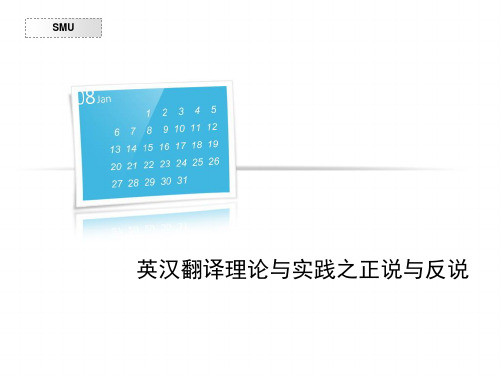
something negative in Chinese, and vice versa.
• Usually applying affirmation or negation depends on meaning or content rather than form.
SMU
• The use of ―yes‖ and ―no‖ is a case in point. —―Are you not going tomorrow?‖ —―No, I’m not going.‖ • Catch me doing that. • 我决不会那样做!
SMU
• Though they extol the virtues of the peaceful life, only one of them has ever gone to live in the country and he was back in town within six months.
SMU
• ④ Negation introduced by preposition, prepositional phrase: above, beyond, past… • It’s past all belief. • 这简直不可思议。 • The ancient vase is above price. • 那个古瓶是无价之宝。 • Air is to man what water is to fish. • 空气对人来说就如水对于鱼来说不可或缺。 • But for workers’ help, we would not succeed in that experiment. • 没有工人的帮助,我们的实验不会成功。
SMU
正说反译
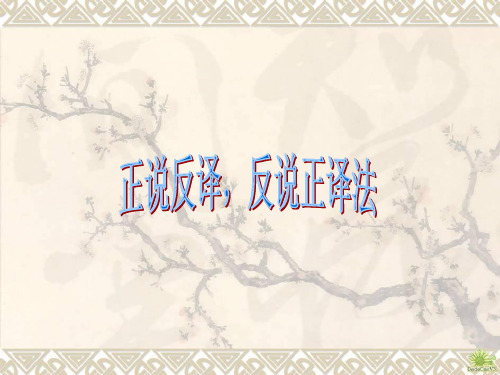
But you see, we both cannot go.
但是我要告诉你,我们俩不能同时都 但是我要告诉你,我们俩不能同时都走。 不能同时
(5)for all one care / know ) You may leave at once for all I care. 你尽可立即离开,我才不管呢。 你尽可立即离开,我才不管呢。 (6)It be + adj. + noun. + that… ) It is a long lane that has no end. 路必有弯。(凡事总会有变化,不会永远不变) 路必有弯。(凡事总会有变化,不会永远不变) 。(凡事总会有变化 It is an ill wind that blows nobody good. 坏事未必对人人都有害处。 坏事未必对人人都有害处。
定义: 定义: Negation作为一种翻译技巧,它主要是指在翻译实践中,为了 作为一种翻译技巧, 作为一种翻译技巧 它主要是指在翻译实践中, 使译文忠实而合乎语言习惯地传达原文的意思, 使译文忠实而合乎语言习惯地传达原文的意思,有时必须把原文 中的肯定说法变成译文中的否定的说法, 中的肯定说法变成译文中的否定的说法,或把原文中的否定说法 变成译文中的肯定说法。因此,在译文技巧中的negation译成 变成译文中的肯定说法。因此,在译文技巧中的 译成 正说反译,反说正译” “正说反译,反说正译”。
• 4)这家机构因公正在国际上享有声誉。 这家机构因公正在国际上享有声誉。 公正在国际上享有声誉 • The agency enjoys an international impartiality.(名词) .(名词 reputation for impartiality.(名词) • 5)她光着脚走进了房间。 光着脚走进了房间 走进了房间。 • She came into the room with no shoes on.(介词短语) .(介词短语 on.(介词短语) • 6)尼克松是个彻底的现实主义者。 尼克松是个彻底的现实主义者。 彻底的现实主义者 • Nixon was nothing if not a realist.(短语) .(短语 realist.(短语)
在英译汉过程中正说反译法的运用探讨
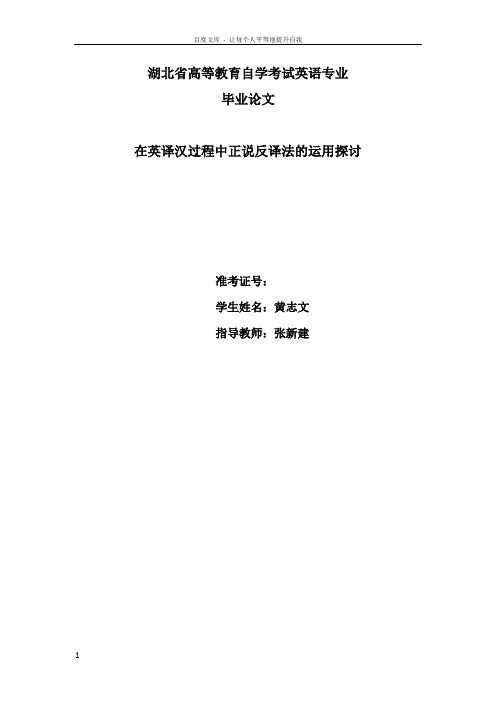
湖北省高等教育自学考试英语专业毕业论文在英译汉过程中正说反译法的运用探讨准考证号:学生姓名:黄志文指导教师:张新建On the Application of Negation during the Course of Translation fom English into ChineseHuang ZhiwenTutor:Zhang Xinjian摘要英语中的否定句表达形式多种多样,英译汉时方法也随之多变。
其中有一类否定句是含蓄否定句,其对应的翻译方法为正说反译法。
本文在中西文化、语言、逻辑思维差异的层面探讨英译汉过程中正说反译法的运用。
最后得出结论:正说反译法是有效调和英汉两种语言矛盾冲突的手段。
关键词:正说反译法、文化、语言、逻辑思维、英译汉Abstract In EnglishKey words:IntroductionIn both English and Chinese,there are negative , they are not completely expressed in the same way, In other words, either of them has its unique way. In general, English negative sentences are much more complicated and various than Chinese ones for its wide range of choices on words, phrases and the ways of expression.In English, we can find a sort of negative sentence which apparently seems to be affirmative sentence. Such a sentence is formally affirmative but actually expresses the negative meaning judging from its meaning .Linguists name this kind of sentence as “Implied Negat ive Sentence”. In the course of translation from English into Chinese, translators are supposed to make out these sentences and select the best approaches to translate them. These sentences are symbolized by the nonequivalence of function and form. It is suggested that the method of negation is the most effective way to fix this problem.A large number of scholars have researched on negation. Unfortunately their researchers are limited to just citing instances and they fail to further their studies. Negation is born from the differences of culture and the habit of thinking between English and Chinese. That we employ negation will exactly reflect the intention of source text and comply with the language specification. This paper attempts to explore the method of negation from the level of culture, linguistics logic thinking, etc. Finally, we draw a conclusion that the approach of negation can be effective to reconcile the contradictions and conflicts between Chinese and English.Chapter One:BackgroundGenerally speaking, when a concept is identified in a certain manner in one language, it can be also identified either in the same or different form in another language. For instance, in Chinese, 是is equal to is,am,are in English. If negated, it will be 不是by adding an negative word不before 是in Chinese. Similarly, it will be all right in English by adding not after is, am, example shows the unity between English and Chinese.Let’s continue looking at two more instances.不好is translated as not good in English. But 很不好cannot be translated into not very good or very not good. When someone asks you “Can’t you speak English?’’, you may answer like this “Yes, I can’t.”(不,我不会) or “No, I can.”(是的,我会). In such a situation, Yes means 不and No means 是,which is so different from our common sense. These two examples reflect the opposition between Chinese and English.Unity and opposites necessarily exist among languages, because languages depend on cultures. Distinct cultures surely cultivate distinct languages. Both similaries and differences exist in every two languages.1.The level of cultureIn the choices of vocabularies, the two languages are not likely to be absolutely consistent, because they are not exactly corresponding ’s life experiences tend to differ from each other and their understanding of the objective world is not consistent. Therefore they don’t select the same words. The expression of the two languages does not coincide.Inner emotion vareies with the difference among nationalities. For example, thanks to the geographical distinctions, the wind has different symbolic significances in Chinese culutre and in English culture. In our mind, the east wind is warm. Itmakes seeds develop and gives life the power to grow. So the famous poet Lan Mao in Song Dynasty wrote a poem which reads “东风破早梅,向暖一枝开。
论英汉翻译中的正话反说与反话正说-副本

On “Direct” and “Indirect”in English-Chinese and Chinese-EnglishSummary: According to the different situation, we need to use a number of different techniques in the process of English-Chinese and Chinese-English Translation. And, this paper discusses a very important skill in English-Chinese and Chinese-English Translation. Both English and Chinese have both positive and negative expressions. However, due to the different thinking modes and expressions in English and Chinese, the two languages have their own unique expressions. In the practice of translation, it will be related to the conversion of positive and negative. Therefore, on the basis of accurate comprehension of the original text, flexibility in the use of word said directly and indirectly, which is the most important translation skill, is the key to ensure the semantic clarity of the version.Keywords: English-Chinese and Chinese-English Translation; direct; indirectlyThings always have positive and negative aspects of the attribute. For some things, English is used to speak directly, Chinese is used to say indirectly; for other things, Chinese is used to say directly, English is used to speak indirectly. This is different from the way of thinking and expression in English and Chinese. In the translation practice, some of the text in the original sentence when they are translated must be processed into reverse, and vice versa. So the “direct”and “indirect”are one of the most important translation skills in English-Chinese and Chinese-English Translation. The “direct”and “indirect” refers to the translation of English, in some of the positive expression of words or sentences,can be expressed from the negative; and also refer to the translation of English, in some of the negative expression of words or sentences,can be expressed from the positive. Here the so-called positive and negative expression mainly refer to the use of not, never, nothing, none, dis-, im-, in-, un-, -less, de-, and so on.“P ositive” into “Negative”The translation of “Positive into Negative ”is divided into two types. On one hand, the source language in the target language is unable to say, which is technically impossible. On the other hand, the source language in the target language can say, and can also say from the opposite. In this situation, to say from the opposite is more authentic, and more in line with the expressions of the target language.Reasons of why to use “Positive into Negative ”are mainly in the following situations: first, both Chinese and English language usage is different; the second is to strengthen the tone. The third is to make it more accurate;Fourth, in some cases, we can’t translate literally. The specific application of “ Positive into Negative ” are discussed in the following examples:1.Chinese and English language usage is different1)His hint escaped me.他的暗示没有引起我的注意。
论英汉翻译中的正话反说与反话正说
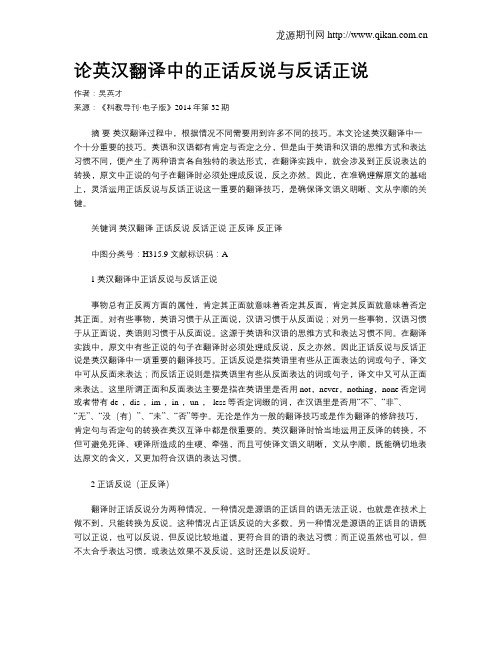
论英汉翻译中的正话反说与反话正说作者:吴英才来源:《科教导刊·电子版》2014年第32期摘要英汉翻译过程中,根据情况不同需要用到许多不同的技巧。
本文论述英汉翻译中一个十分重要的技巧。
英语和汉语都有肯定与否定之分,但是由于英语和汉语的思维方式和表达习惯不同,便产生了两种语言各自独特的表达形式,在翻译实践中,就会涉及到正反说表达的转换,原文中正说的句子在翻译时必须处理成反说,反之亦然。
因此,在准确理解原文的基础上,灵活运用正话反说与反话正说这一重要的翻译技巧,是确保译文语义明晰、文从字顺的关键。
关键词英汉翻译正话反说反话正说正反译反正译中图分类号:H315.9 文献标识码:A1英汉翻译中正话反说与反话正说事物总有正反两方面的属性,肯定其正面就意味着否定其反面,肯定其反面就意味着否定其正面。
对有些事物,英语习惯于从正面说,汉语习惯于从反面说;对另一些事物,汉语习惯于从正面说,英语则习惯于从反面说。
这源于英语和汉语的思维方式和表达习惯不同。
在翻译实践中,原文中有些正说的句子在翻译时必须处理成反说,反之亦然。
因此正话反说与反话正说是英汉翻译中一项重要的翻译技巧。
正话反说是指英语里有些从正面表达的词或句子,译文中可从反面来表达;而反话正说则是指英语里有些从反面表达的词或句子,译文中又可从正面来表达。
这里所谓正面和反面表达主要是指在英语里是否用not,never,nothing,none否定词或者带有de-,dis-,im-,in-,un-,-less等否定词缀的词,在汉语里是否用“不”、“非”、“无”、“没(有)”、“未”、“否”等字。
无论是作为一般的翻译技巧或是作为翻译的修辞技巧,肯定句与否定句的转换在英汉互译中都是很重要的。
英汉翻译时恰当地运用正反译的转换,不但可避免死译、硬译所造成的生硬、牵强,而且可使译文语义明晰,文从字顺,既能确切地表达原文的含义,又更加符合汉语的表达习惯。
2正话反说(正反译)翻译时正话反说分为两种情况。
汉英翻译--正说与反说

• (3)部队宁可绕道走,也不踩庄稼。 • The troops would rather take a roundabout way than tread on the crops. • (4)快一点,否则你就要迟到了。 • Hurry up, or you'll be late.
• (4) 我们决不辜负全国人民对我们的希望。(反 说;译文可正说) • We will live up to the expectations of our people. • (5) 他的解释不能让人满意。(反说;译文可正 说) • His explanation is far from satisfactory. • (6) 他虽然贫穷,但无论如何也不会说谎。(反 说;译文 可正说〉 • Poor as he was, he was above telling a lie in any case. • 汉译英中,正说与反说互相转换的现象很多, 转换的原因主要有下列三种
3.形容词和形容词短语few, little, free from, far from, safe from, short of 等等。例如: • (1) 这次演出根本没有失败,而是十分成功。 • The show was far from being a failure; it a great success. • (2) 他的作文中几乎没有语法错误。 • There are few grammatical mistakes in his composition. • (3) 据悉敌军给养不足。 • It is reported that the enemy troops are short of supplies.
翻译课件6--正反译法

6. Appearances are deceptive.
外貌是靠不住的。
第四章:翻译技巧(上)——正说反译、反说正译法
[<]
D: The Shift of Perspectives (视角转换)
7 .Good winner, good loser.
胜不骄,败不馁。
8. 在美国,人人都能买到枪。
原译:In the United States, everyone can buy a gun.
[<]
1. I have failed to convince him of his error.
2. 我没能说服他,让他知道自己的错误。
3. 2. The teacher found some of the students absent.
4. 老师发现有的学生不在。
5. 3. His answer is beside the mark. 6. 他的回答文不对题。
第四章:翻译技巧(上)——正说反译、反说正译法
[<]
A. Some Idiomatic Expressions
1. riot (raiət) police 防暴警察 (即anti-riot police,而不是暴乱的警察)
2. crisis law 反危机法案 (即anti-crisis law)
连词
▪ 26)Before I could say “thank you”,the postman had disappeared around the corner.
▪ 译文:我还没来得及说声“谢谢”,邮递员已 经在拐角处不见了。
▪ 27) The soldiers would fight to death before they surrendered.
英汉互译中的正反反正表达法
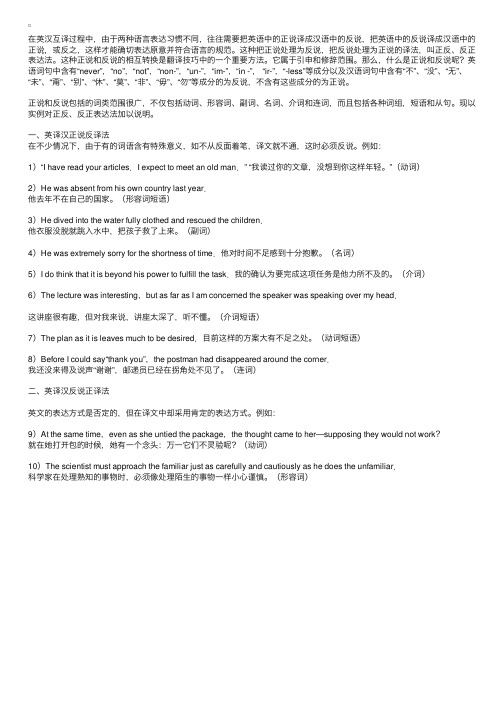
在英汉互译过程中,由于两种语⾔表达习惯不同,往往需要把英语中的正说译成汉语中的反说,把英语中的反说译成汉语中的正说,或反之,这样才能确切表达原意并符合语⾔的规范。
这种把正说处理为反说,把反说处理为正说的译法,叫正反、反正表达法。
这种正说和反说的相互转换是翻译技巧中的⼀个重要⽅法。
它属于引申和修辞范围。
那么,什么是正说和反说呢?英语词句中含有“never”,“no”,“not”,“non-”,“un-”,“im-”,“in -”, “ir-”,“-less”等成分以及汉语词句中含有“不”、“没”、“⽆”、“未”、“甭”、“别”、“休”、“莫”、“⾮”、“⽏”、“勿”等成分的为反说,不含有这些成分的为正说。
正说和反说包括的词类范围很⼴,不仅包括动词、形容词、副词、名词、介词和连词,⽽且包括各种词组,短语和从句。
现以实例对正反、反正表达法加以说明。
⼀、英译汉正说反译法在不少情况下,由于有的词语含有特殊意义,如不从反⾯着笔,译⽂就不通,这时必须反说。
例如:1)“I have read your articles.I expect to meet an old man.” “我读过你的⽂章,没想到你这样年轻。
”(动词)2)He was absent from his own country last year.他去年不在⾃⼰的国家。
(形容词短语)3)He dived into the water fully clothed and rescued the children.他⾐服没脱就跳⼊⽔中,把孩⼦救了上来。
(副词)4)He was extremely sorry for the shortness of time.他对时间不⾜感到⼗分抱歉。
(名词)5)I do think that it is beyond his power to fulfill the task.我的确认为要完成这项任务是他⼒所不及的。
商务英语翻译3词类转换正说反译与反说正译

精选ppt课件
16
2.3. 副词转译成名词
▪ The supermarket would give everyone 10% off on all cash purchases.
▪ 那家超市将给每一位用现金购物的顾客10% 的优惠( 折扣)。
▪ What is the fare to London and back? ▪ 去伦敦一个来回需要多少钱?
些介词在汉译时往往译成动词。如:
▪ The judge sat in the dining room amid (处理)his morning mails.
▪ Carlisle Street runs westward(向西延伸), across (越过) a great black bridge, down (爬下)a hill and up(爬上) again, by (经过)little sloops(单桅船) and meat markets, past (路过)single storied homes, until suddenly it stops against a wide green lawn.(…冲着一大片绿色草地中止 了。)
▪ Warm discussion arose on every corner as to his achievements.
▪ 到处在热烈地讨论他的成就。 ▪ We took brief, restless naps, struggled to
understand the intermittent broadcasting of the radio. ▪ 我们短短地,不安地睡了几次,竭力想听懂收音机 里断断续续的广播。
会计包括设计会计制度,准备财务报表,审计成本研究报 告,开展预测,计算收入所得税,运用计算机,以及分析 和解 释有助于做出商业决策的会计信息。
英汉翻译中的正反表达法

习惯用法
28) He is anything but a writer. 译文:他决不是一个作家。 29)The islanders found themselves far from ready to fight the war. 译文:岛民发现自己远远没有做好作战准备。 30)The decision has to come. 译文:决定尚未作出。 31)It is a wise father that knows his own child. 译文:无论怎样聪明的父亲也不见得了解自己的孩 子。
形容词
12)The light in the classroom is poor. 译文:教室里的光线不足。 13)The explanation is pretty thin. 译文:这个解释站不住脚。 14)He was absent from his own country last year. 译文:他去年不在自己的国家。 15)At present it is generally accepted, although more as a self-evident statement than on the base of a closelyreasoned scientific proof. 译文:目前,这个观点已被普遍接受,虽然它是不言而喻的, 并不是根据科学严密推理而证明的。
英语翻译正说反译反说正译
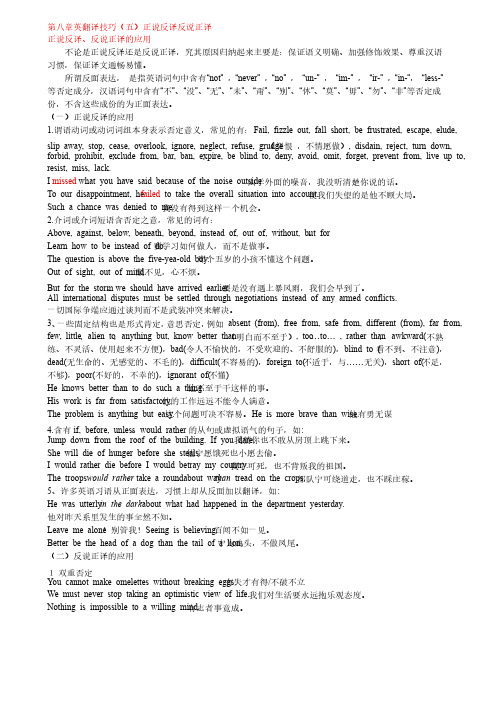
第八章英翻译技巧(五)正说反译反说正译正说反译、反说正译的应用不论是正说反译还是反说正译,究其原因归纳起来主要是:保证语义明确、加强修饰效果、尊重汉语习惯,保证译文通畅易懂。
所谓反面表达,是指英语词句中含有“not”,“never”,“no”,“un-”,“im-”,“ir-”,“in-”,“less-”等否定成分,汉语词句中含有“不”、“没”、“无”、“未”、“甭”、“别”、“休”、“莫”、“毋”、“勿”、“非”等否定成份,不含这些成份的为正面表达。
(一)正说反译的应用1.谓语动词或动词词组本身表示否定意义,常见的有:Fail, fizzle out, fall short, be frustrated, escape, elude, slip away, stop, cease, overlook, ignore, neglect, refuse, grudge(怨恨,不情愿做), disdain, reject, turn down, forbid, prohibit, exclude from, bar, ban, expire, be blind to, deny, avoid, omit, forget, prevent from, live up to, resist, miss, lack. I missed what you have said because of the noise outside.由于外面的噪音,我没听清楚你说的话。
To our disappointment, he failed to take the overall situation into account. 使我们失望的是他不顾大局。
Such a chance was denied to me.我没有得到这样一个机会。
2.介词或介词短语含否定之意,常见的词有:Above, against, below, beneath, beyond, instead of, out of, without, but for。
论英汉翻译中的正话反说与反话正说
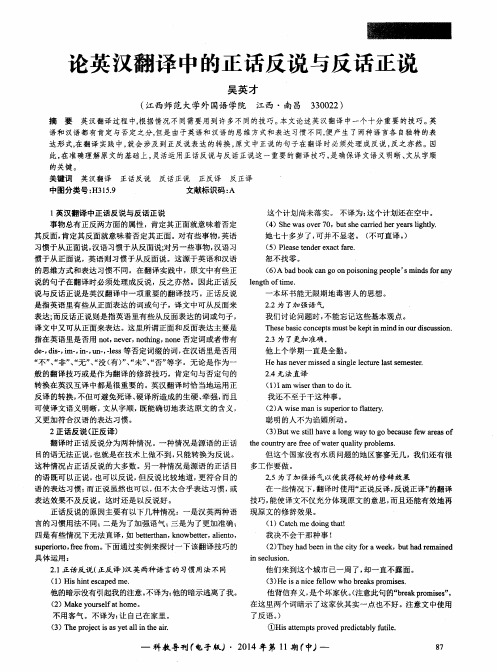
的关键。
关键词
英汉翻译
正话反说
反话正说 正反译
反正译
中图分 类号 : H3 1 5 . 9
文献标识码 : A
这个 计划 尚未 落 实 。 不译 为 : 这 个 计划 还 在 空 中 。
又更 加 符 合 汉 语 的表 达 习惯 。
2 . 4无 法 直译
( 1 ) I a m wi s e r t h a nt od oi t .
我还不至于干这种事。
( 2 ) A wi s e ma rl i s s u p e r i o r t o la f t t e r y .
l e n g t h o f t i me .
一
的思维方式和表达 习惯不 同。在翻译实践中,原文中有些 正
说 的句子在翻译时必须处理成反说,反之亦然。因此 正话反
说与反话正说是英汉翻译 中一项重要的翻译技巧。正话反 说
是 指 英 语 里 有 些 从 正 面 表 达 的 词 或 句 子 ,译 文 中 可从 反 面 来
她七十多岁 了, 可 并不 显老 。 ( 不可直译。 )
( 5 )P l e a s e t e n d e r e x a c t f a r e .
恕不 找 零 。
( 6 ) A b a d b o o k c a n g o o n p o i s o n i n g p e o p l e ’ S mi n d s f o r a n y
本 坏 书 能无 限期 地 毒 害 人 的思 想 。
2 - 2为 了加 强 语 气
汉互译中的动词正、反表达方法举偶 绝对有用

litter.如果你不去注意那些垃圾,
one’s to
teacher.他完全没有留意老师所讲的那一番话。
She saw
你就会发现这个公园很美。
close/shut “allow
to
him
coming
but
she
i璺nored
eyes
something意为
him.她看见他走过来,但装作没看见。 上述两句中的ignore只能采用“没有留意 ……”、“假装没有……”等汉语反说的表达形
等最常用的动词均具有“一反常态”的妙用。我 们在进行英汉动词互译时,切不可信手直译。
from going.由于下
雨,我们无法前往。
Peace
there]不要闹!
万方数据
letter,telling
him of my
marriage,
to
exist.这个国家已
must just have
missed him.他偏偏没有收到我
不再存在了。
We唑concerning
矗te of people within
告诉他我结婚的那封信。
ourselves“、7l,idl the the frontiers of che
This country
ceases
式才能确切地表达英语原句中动词所内含的强 烈语气。 “My mother
out,but
I
will—kill
care,”
me when she finds
said
don’t
Betty.贝蒂说:
“我母亲要是知道了,准饶不了我,不过我不在
乎。”
将上句中的kill译为“饶不了”,措辞是十 分和谐的。如果将该词直译为“杀了”或“宰 了”等,语气则显得十分过火且容易引起误解。 My
英汉翻译中的正说反译和反说正译的探讨
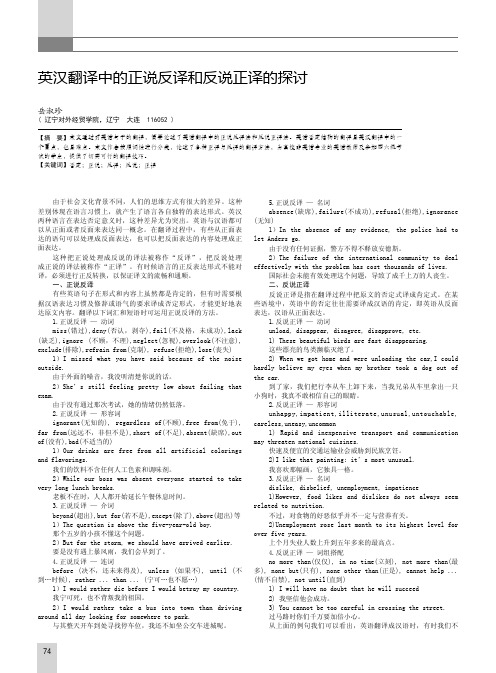
74英汉翻译中的正说反译和反说正译的探讨岳淑珍( 辽宁对外经贸学院,辽宁 大连 116052 )【摘 要】本文通过对英语句子的翻译,简要论述了英语翻译中的正说反译法和反说正译法。
英语否定结构的翻译是英汉翻译中的一个重点,也是难点。
本文作者按照词性进行分类,论述了各种正译与反译的翻译方法,为高校非英语专业的英语教师及参加四六级考试的学生,提供了切实可行的翻译技巧。
【关键词】否定;正说;反译;反说;正译由于社会文化背景不同,人们的思维方式有很大的差异。
这种差别体现在语言习惯上,就产生了语言各自独特的表达形式。
英汉两种语言在表达否定意义时,这种差异尤为突出。
英语与汉语都可以从正面或者反面来表达同一概念。
在翻译过程中,有些从正面表达的语句可以处理成反面表达,也可以把反面表达的内容处理成正面表达。
这种把正说处理成反说的译法被称作“反译”,把反说处理成正说的译法被称作“正译”。
有时候语言的正反表达形式不能对译,必须进行正反转换,以保证译文的流畅和通顺。
一、正说反译有些英语句子在形式和内容上虽然都是肯定的,但有时需要根据汉语表达习惯及修辞或语气的要求译成否定形式,才能更好地表达原文内容。
翻译以下词汇和短语时可运用正说反译的方法。
1.正说反译 — 动词miss(错过),deny(否认,剥夺),fail(不及格,未成功),lack (缺乏),ignore (不顾,不理),neglect(忽视),overlook(不注意), exclude(排除),refrain from(克制), refuse(拒绝),lose(丧失)1)I missed what you have said because of the noise outside.由于外面的噪音,我没听清楚你说的话。
2)She’s still feeling pretty low about failing that exam.由于没有通过那次考试,她的情绪仍然低落。
正说与反说

当关系代词和主从连词的but 前面出现否定词no, never, few, not, nobody等时,一般可将其理解为 “that…not” 或 “who…not”和前 面的否定词一起构成前后双重否定的形式。 I desired nothing but to go home. 我只希望回家。
No sooner…than。本句型不表示否定比较意义,而是表达 “一…. 就….”之意。 No sooner had I started than it began to rain. 我一准备出发天就下 雨了。
4.形容词及形容词词组:在英译汉中,有一些形容词虽然形式上肯定,却有否定的 意思,它们在汉译时经常被译成否定句。 例如:Appearance is deceptive. 外貌是靠不住 靠不住的 外貌是靠不住的。 2.副词与连词:有些情况下,一些英语副词或连词应该译成否定式。使句子更有 说服力。 例如:I won’t go unless he comes back. 要是他不回来,我就不去。 不 3.固定短语及句式(1).too..to不定式: 太……以至于不能 (2)主语+be+ the last+名词+不定式或定语从句: 绝不至于……,最不…… (3)prefer+to不定式+rather than+ 3 prefer+to +rather than+不带to: 宁愿……不愿…… to …… …… (4)would rather/sooner ……than…… :宁愿……而不愿…… (5)more……than……和rather than……是……而不是…… (6)形容词或副词的比较几+than +to不定式。 (7)根据一定的上下文用肯定的疑问句表达强烈的否定。 (8)英语中还有许多以肯定句形式出现的省略句感叹句和条件从句,她们均可 根据上下文情况翻译成否定句式,使译文忠于原文。 If ever I heard the like! 对此我真是闻所未闻 闻所未闻。 闻所未闻 二.汉译英的正反翻译法: 汉语中有些词语是肯定的,但译成英语确实否定的。 例如:He behaved unusually this afternoon. 下午他表现的很特别 特别。 特别
谈汉英翻译中的正反互译

( ) 而能 够 做 到 这 点 的 企 业并 不多 见 。 9然
Ye , w og n z t n r b et n t n i i ma n r tf r a iai sae a l f c i nt s n e . e o Ou o h
这 是 一个 反 说 正 译 的例 子 .按 照 汉 语 的 习 惯 可 以 说 “ 在 没 有 … … 以前 ” ,但 是 这 种 说 法 不 合 英 语 习 惯 , 如译 成 “ e r te ee t a ob e ge ”就 使 人无 法理 解 了 。 B f e h ci s t en i d , o r ph n sn ( ) 也 奇 怪 . 似 乎 忘 了他 最 喜 爱 的 诗 人 的名 字 。 2说 他
… …
3英 语 中含 有 否 定 半 否 定 的词 汇和 短 语 . 由 以上 译 例 可 以看 出 , 译英 时 , 了 正 确 处 理 正 说 和 反 汉 为 说 的转 换 , 译者 可 以灵 活 地 变 换 句 型 , 可 以利 用 反 义 词 。 此 也 外 , 语 中有 许 多含 有 否 定 或 半 否 定 语 气 的 词语 , 翻译 中 译 英 在 者可 充 分 利 用 , 以便 使 译 文符 合 英 语 习惯 , 使 句 子 结 构 多 样 并 化 。那 么 , 英语 巾含 有 否 定 语 气 的词 语 都 有 哪 些 呢 ? 动 词 如 rfs , s d n ,obd,v i d u tec p ,al eu e mi e y fri a od, o b ,sa e fi, s, wo d rrf i .eete p c等 。例 如 : n e ,er n rjc ,x e t a (0 我 读 过 你 的 文 章 。 不 到 你 这么 年 轻 。 1) 想
正说反译与反说正译
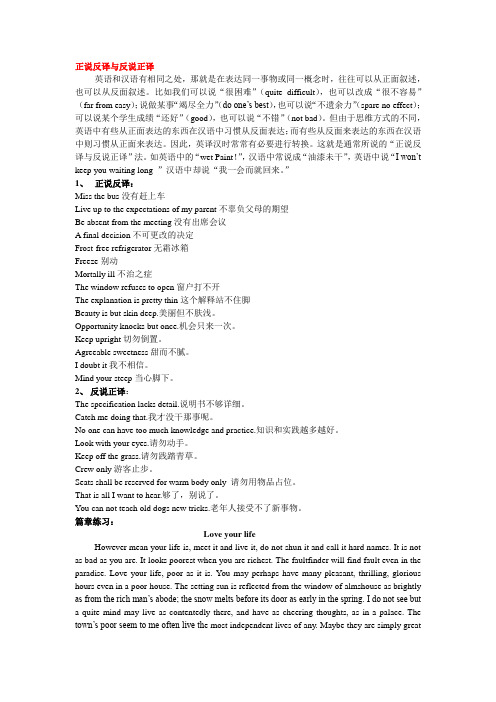
正说反译与反说正译英语和汉语有相同之处,那就是在表达同一事物或同一概念时,往往可以从正面叙述,也可以从反面叙述。
比如我们可以说“很困难”(quite difficult),也可以改成“很不容易”(far from easy);说做某事“竭尽全力”(do one’s best),也可以说“不遗余力”(spare no effect);可以说某个学生成绩“还好”(good),也可以说“不错”(not bad)。
但由于思维方式的不同,英语中有些从正面表达的东西在汉语中习惯从反面表达;而有些从反面来表达的东西在汉语中则习惯从正面来表达。
因此,英译汉时常常有必要进行转换。
这就是通常所说的“正说反译与反说正译”法。
如英语中的“wet Paint!”,汉语中常说成“油漆未干”,英语中说“I won’t keep you waiting long ”汉语中却说“我一会而就回来。
”1、正说反译:Miss the bus没有赶上车Live up to the expectations of my parent不辜负父母的期望Be absent from the meeting没有出席会议A final decision不可更改的决定Frost-free refrigerator无霜冰箱Freeze别动Mortally ill不治之症The window refuses to open窗户打不开The explanation is pretty thin这个解释站不住脚Beauty is but skin deep.美丽但不肤浅。
Opportunity knocks but once.机会只来一次。
Keep upright切勿倒置。
Agreeable sweetness甜而不腻。
I doubt it我不相信。
Mind your steep当心脚下。
2、反说正译:The specification lacks detail.说明书不够详细。
英汉翻译法7——正反译法

⏹在翻译时,对于中国学生来说,某些否定句犹如陷阱,稍有不慎,就会掉入其中。
鉴于此,我们在翻译某些含有否定意义的句子时,应当把握两点:一、英语里有些从正面表达的词或句子,译文可从反面来表达,即正说反译法;二、英语里有些从反面表达的词或句子,译文可从正面来表达,即反说正译法。
例如:⏹1) Only five customers remained in the bar.⏹酒吧间只有五个顾客还没走。
⏹(原文从正面表达,译文从反面表达。
如译成“还留着”,或“还呆在那里”,则不如“还没有走”更符合汉语习惯。
)⏹2)Anyone wants to get out? Over my dead body!⏹只要我活着,谁也别想出去。
(the original English sentence implies “nobody can get out unless you kill me).⏹3) Mother said Father would come soon, but Mary knew better.⏹妈妈说爸爸很快就会来了,玛丽知道不会。
(“know better” implies that Mary thoug ht differently or disagreed with Mother, it means “think otherwise”)⏹5) A radar screen is not unlike a television.⏹雷达荧光屏跟电视荧光屏一样。
⏹(如译成“雷达荧光屏不是不象电视荧光屏一样”则不符合汉语习惯。
)⏹我们可以看到,正面译不顺,不妨从反面译;反面译不顺,不妨从正面译,因为同一个概念,一个民族正面说,认为是合乎表达习惯的,而另一个民族则认为反着说才顺嘴。
⏹下面从正说反译和反说正译这两个方面来探讨英语否定结构汉译的一般原则⏹一、正说反译法(Affirmative in English, but Negative in Chinese)⏹英语中的含蓄否定词或含蓄否定短语一般都要译成汉语的否定词组。
- 1、下载文档前请自行甄别文档内容的完整性,平台不提供额外的编辑、内容补充、找答案等附加服务。
- 2、"仅部分预览"的文档,不可在线预览部分如存在完整性等问题,可反馈申请退款(可完整预览的文档不适用该条件!)。
- 3、如文档侵犯您的权益,请联系客服反馈,我们会尽快为您处理(人工客服工作时间:9:00-18:30)。
英汉互译中正说与反说探讨
在英汉互译的过程中,如果我们执意要按照字词的本身去翻译,在语言上就会显得生硬、不流畅,从而使句子和文章产生翻译遗憾。
然而,使用正反说翻译法,对这个问题就可以迎刃而解,翻译出来的句子就会有声有色,顺理成章,达到意想不到的效果。
标签:翻译;正说;反说
进入21世纪,随着国际间交往的频繁,英语这个媒介就成了最大众化的交际工具了。
其独特的实用性、普遍性在我国的对外交往中扮演着越来越重要的角色。
而英语翻译又在其中起着桥梁和纽带的作用。
一般来说,翻译可分为直译和意译,无论笔译还是口译都牵涉这一既简单又复杂的原理。
很多情况下,直译的效果是生搬硬套的,听起来不顺,因为某些句子的翻译是需要根据语境,及对有关国家的风土人情有一定的了解的同时综合应用本身的知识进行翻译,即意译。
1 正说与反说的内涵
本文所述的“正说”与“反说”属于意译的范畴,是引申的翻译。
正说,是以常规的思维方式和逻辑推理就能够得出的翻译,以肯定的方式表达;而反说就是改变一下思维的角度从反面推理得出译意的一种否定表达方式。
反说不仅仅包括形容词,也包括副词、名词、动宾词组,介词词组和不定式词组等等。
由于英汉两种语言,在语法结构上,在社会、文化、历史、风土人情方面存在差异,往往初学者在翻译过程中会出现这样和那样的错误和牵强附会以致词不达意,因此,常需要把英语中的正说译成汉语中的反说。
英语虽然是正说,但译成汉语的反说往往更能表达作者的原意,同时,更能符合汉语的习惯;反过来,有时也需要把英语中的反说译成汉语中的正说,才能曲尽原意。
要想将正反说互译得更好,要选取相关的词语,进行反复的推敲,从汉语中相关场景和氛围中找相应的词汇和表达方式来进行翻译。
另一方面,译者还必须具备较高的文学素养和渊博的知识,能熟练运用中国成语、俗语、俚语等使得译文流利顺畅,读来毫无晦涩之感,让读者可以越过语言的障碍,在对原文理解正确上与作者达成默契与共鸣。
下面来举一些例子说明这一转换的原理。
2 正说变反说
常见是的正说变反说,也比较容易理解。
例如:
1.Wet Paint! 译成:油漆未干!
2. We have an although open mind.译成:我们完全没有成见。
3.This explanation is quite thin.译成:这种解释的理由很不充分。
4. Appearances are deceptive.译成:外表是靠不住的。
5.This is sometimes a blessing in disguise.译成:有时,这是塞翁失马,焉知非福。
6.The board was closely divided on the question.译成:董事会在这个问题上意见分歧,双方势均力敌,相差无几。
7.He dived into the water fully clothed and rescued the children. 译成:他没有脱衣服就跳入水中,把孩子们救起来。
8.They had been in Shanghai for a week, but had remained in seclusion.译成:他们来到上海已经一个礼拜了,却一直没有露面。
9.I felt so much at ease that I found myself speaking. 译成:无觉得无拘无束,就不知不觉说起来话来。
10.He seemed to be at a loss for the precise word to complete his thought.译成:他似乎想不出恰当的字眼来把他的思想充分表达出来。
11.They could accept the plan with dignity.译成:他们可以接受这个方案而又不失体面。
12.She has an incisive manner of speaking, happily free from umms and ers. 译成:她说话干脆果断,完全没有哼哼哈哈的腔调。
13.We protested in vain.译成:我们提出了抗议,但毫无用处。
14.The main shortcoming of his article is lack of economy.译成:他的文章的主要缺点,是不惜笔墨。
15.John was a fool for danger. 译成:约翰是一个天不怕、地不怕的家伙。
16.Shortness of time has required the omission of some states. 译成:由于时间短促,没有能访问某些国家。
17.He accused them of bad faith. 译成:他指责他们不守信用。
18.Such a chance was denied me.译成:我没有得到这样的机会。
was passed over by the industrial revolution.译成:工业革命没有光顾亚洲。
20.We decided that as it was only for a few days our pocket book would stand
the strain.译成:我们断定,由于我们只呆几天的时间,我们的钱袋子还不至于告罄。
22.The news media were barred from the party. 译成:没有让新闻记者采访这次宴会。
23.He accused the administration of standing still on vital issues.译成:他指责行政部门在重点问题上裹足不前。
24.I am tempted here to a quotation which I own to Einstain. 译成:在这里,我不禁想起爱因斯坦的一段话。
需要注意的是,有时英语中的正说译成汉语中的正反说均无不可。
翻译的时候也要看具体情况而定。
例如:
The government had something of a case. 译成:政府也不是完全没有理由。
或可译成:政府也是有一定的理由的。
在把实际动作动词改译为言语和思维动作动词时,也可以把正说转换成反说。
例如:
The officials minimized the senator’s criticisms.译成:官员们指出,这位参议院的批评根本不值得重视。
3 反说变正说
在英汉翻译中,反说变正说比较困难一些,既要求译者有较高的语言文学修养,还要求译者用心思索。
现在略举数例如下:
1.He lived in an insecure building. 译成:他住在一座危楼中。
2.A state of uncertainty must disgust and alarm. 译成:扑朔迷离的政局一定会引起人们的反感和惊恐。
3.It never occurred to me not to endeavor to do so. 译成:我从来没有想过要打退堂鼓。
4.In spite of our mentioning many times, they would not follow our plan and go their own ways. 译成:虽然我们提醒多次,但是他们仍然坚持己见。
5.Evidently he had the first quality of an angler, which is not to measure the pleasure by the catch.译成:显然,他具备了垂钓者最重要的品质,即,以垂钓为乐,不管钓多钓少。
6.The thought of returning to his native land never deserted him amid his
tribulation.译成:在苦难中,重返故土的念头始终在他心头萦绕着。
7.His speech leaves nothing to be desired.译成:他的演讲好极了。
8.These are not always unmixed blessings. 译成:这些事情并不是总是纯益无害。
总之,在进行英汉互译的时候, 无论是从原文的肯定形式转换为译文的否定形式, 还是原文的否定形式转换成译文的肯定形式, 或是保持原文的形式, 都只是形式上的变化,最主要的还是要由译文的内容来决定翻译的本质。
正说和反说的相互转换是翻译技巧中的一个重要的方法,属于引申的范畴,需要不断地学习和实践方能够熟练掌握。
参考文献
[1]高雷.英汉翻译中的正反译与反正译[J].徐州工程学院学报,2006,(11).
[2]周幼华.漫谈汉英互译中的正说与反说译法[J].大学英语(学术版),2008,(2).
[3]任崇芬.“正说反译”与“反话正说”―兼议反语分类[J].四川教育学院学报,2006,(9).。
